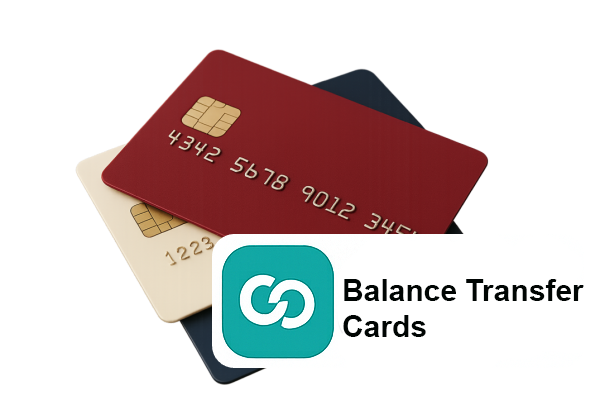Car Finance
HP Car Finance
PCP Car Finance
Used Car Finance
No Deposit Car Finance
Bad Credit Car Finance
Refinance Car
Compare Credit Cards
0% Balance Transfer Cards
0% Purchase Cards
Money Transfer Credit Cards
Credit Building Credit Cards
Check Your Eligibility
Compare Current Accounts
Compare Savings Accounts
High-interest current accounts
Cashback accounts
Packaged bank accounts
Business Loans
Working Capital Loans
Merchant Cash Advance (MCA)
Commercial Finance
Small Business Loans
Business Expansion Loan
Debt Refinance
Invoice Finance
Revenue Based Loans
Asset Finance
Property Finance
Secured Business Loans
Bridging Loans
Commercial Mortgages
Business Credit Cards
Credit Line for Business
0% Balance Transfer Cards
Low-Interest Business Credit Cards
Money transfer credit cards
Credit building credit cards
Business Bank Account
Business Savings Account
Balance Transfer Cards
A financial option to help consumers manage and reduce existing credit card debt more effectively.
4.7
Customer Reviews
Get started today
Warning: Late repayment can cause you serious money problems. For more information, go to moneyhelper.org.uk

What Are Balance Transfer Credit Cards?
Ready to get started?
Compare loans in 3 simple steps

1. Loan Details
Tell us how much you need, for how long and for what purpose.

2. See offers
We find you the loan offers you qualify for from multiples lenders.

3. Select
Select the loan that best matches your circumstances and Get Funded.
The LoanTube Pledge
Searching for a loan on LoanTube won’t impact your credit score. We do not sell your data to any third parties.
Educated guesses aren't good enough
You choose the terms, we do the math.
Check your affordability with our Business Loan calculator and make an informed financial decision.
Get started today
The rate you get will depend on your individual, financial circumstances. Late repayment can cause you serious money problems. For more information, Go to moneyhelper.org.uk
Get started today
£100,000
Loan Term
Total repayment
Monthly repayment
RAPR
Interest
32 Months
£119,173.27
£3,819.66
14.4%
14.4% p.a (Fixed)
The rate you get will depend on your individual, financial circumstances. Late repayment can cause you serious money problems. For more information, Go to moneyhelper.org.uk
How Balance Transfer Cards Work
Balance transfer fees represent another important consideration. While this fee increases your overall debt, it is often worthwhile when compared to the interest savings achieved during the promotional period. However, consumers should calculate the total cost including fees to ensure the transfer provides genuine financial benefit.
The primary advantage of balance transfer cards lies in the substantial interest savings they can provide during the promotional period. For consumers carrying significant credit card debt at standard rates of 20-30% APR, transferring to a card can save hundreds or thousands of pounds in interest charges. This saving is particularly significant for larger balances, where the monthly interest charges on existing cards may be preventing meaningful debt reduction.
The breathing space provided by interest allows consumers to focus their payments on reducing the principal debt rather than servicing interest charges. This can accelerate debt repayment significantly, particularly when combined with a disciplined approach to avoiding new spending on credit. Many consumers find that the psychological benefit of seeing their debt balance reduce each month, rather than remaining static due to interest charges, provides additional motivation to maintain their repayment efforts.
Balance transfer cards can also provide an opportunity to improve credit scores over time, provided payments are made consistently and on time. By reducing overall credit utilisation across multiple cards and demonstrating responsible credit management, consumers may see improvements in their credit rating. However, this benefit only materialises with disciplined financial behaviour and consistent payments.
Debt Accumulation and Double Jeopardy Risk: One of the most serious disadvantages of balance transfer cards lies in the substantial risk of accumulating additional debt, creating what financial experts term “double jeopardy” situations. For example, imagine you move £4,000 of high‑interest debt onto a card that pauses interest charges on that amount for 12 months, and then use the same card to spend a further £500. Because the promotional pause applies only to the transferred balance, any new purchases begin accruing interest right away at the card’s standard rate—often around 20% per annum. If, after a year, you still owe part of the original £4,000, that remaining sum will also start accruing interest at the regular rate, leaving you with two separate balances both charging interest at the same time.
The compound effect of accumulating new debt while servicing transferred balances can quickly overwhelm household budgets. Consumers may find themselves unable to meet minimum payments across multiple cards, leading to missed payments, penalty charges, and rapid deterioration of credit scores. This situation often results in consumers becoming trapped in high-cost credit cycles, where they rely increasingly on expensive forms of borrowing to meet basic living expenses.
Interest Rate Reversion and Payment Shock: The temporary nature of paused rates creates significant risks when these periods expire, often resulting in what financial advisors term “payment shock”. Most balance transfer cards revert to standard variable rates of 20-30% APR once the promotional period ends, which can be higher than the original cards from which debt was transferred. This reversion can dramatically increase monthly payment requirements, potentially making the debt unaffordable for consumers who have not cleared the balance during the promotional period.
The FCA’s research indicates that many consumers underestimate the impact of rate reversions, with approximately 60% failing to calculate the post-promotional payment requirements before applying for balance transfer cards. This lack of forward planning can result in severe financial difficulties when promotional rates expire, particularly for consumers with large transferred balances who have made only minimum payments during the promotional period.
The timing of rate reversions often coincides with other financial pressures, such as increased living costs or reduced income, creating perfect storm scenarios for financial distress. Consumers who have become accustomed to lower payment requirements during the promotional period may struggle to adjust their budgets to accommodate significantly higher payments when standard rates apply.
The calculation complexity surrounding post-promotional payments often exceeds the financial literacy levels of many consumers, leading to poor decision-making and inadequate preparation for rate changes. Consumers should seek professional guidance to understand the full implications of rate reversions before committing to balance transfer products.
Transfer Fees and Hidden Costs: Balance transfer fees represent a significant upfront cost that can substantially increase the total debt burden, with most providers charging between 2-4% of the transferred amount. For consumers transferring large balances, these fees can amount to hundreds or thousands of pounds, immediately increasing the debt that needs to be repaid. Providers are required to clearly disclose these fees, but research suggests many consumers underestimate their impact on total borrowing costs.
Hidden costs associated with balance transfer cards extend beyond transfer fees to include potential charges for exceeding credit limits, making late payments, or using cards for cash advances. These additional charges can quickly accumulate, particularly for consumers who are already struggling with debt management. The complexity of fee structures often makes it difficult for consumers to accurately calculate the total cost of balance transfer products.
The opportunity cost of transfer fees should also be considered, as these amounts could otherwise be used to reduce existing debt balances. For consumers with limited financial resources, paying substantial transfer fees may delay debt reduction and extend the period required to achieve financial stability.
Credit Score and Financial Profile Impact: Balance transfer applications typically involve hard credit searches that can temporarily reduce credit scores, particularly problematic for consumers who may need to apply to multiple providers to secure approval. Consumers with existing debt problems often have impaired credit profiles, making them more vulnerable to credit score reductions from multiple applications.
The impact of balance transfers on credit utilisation ratios can be complex and potentially negative, particularly when large balances are concentrated on single cards. While overall utilisation across multiple cards may improve, having high balances on individual cards can negatively impact credit scores, potentially affecting future borrowing opportunities and insurance premiums.
The timing of credit score impacts can be particularly problematic for consumers who may need access to other forms of credit, such as mortgages or personal loans, in the near future. The temporary reduction in credit scores following balance transfer applications can affect the terms offered on other credit products, potentially costing consumers thousands of pounds in higher interest rates or fees.
Long-term credit profile implications include the potential for balance transfer cards to remain on credit files for extended periods, particularly if consumers struggle to manage the transferred debt effectively. Missed payments or defaults on balance transfer cards can have severe and lasting impacts on credit scores, affecting financial opportunities for years to come.
Eligibility Restrictions and Limited Access:
The eligibility criteria for balance transfer cards often exclude consumers who would benefit most from these products, creating a paradox where those with the greatest need have the least access. Providers typically require excellent credit scores and stable income levels, effectively limiting access for consumers experiencing financial difficulties or those with impaired credit histories.
The credit limits offered on balance transfer cards may be insufficient to consolidate all existing debts, forcing consumers to maintain multiple credit relationships and potentially limiting the effectiveness of the debt consolidation strategy. Partial transfers can complicate debt management and may not provide the financial relief that consumers expect from balance transfer products.
Geographic and demographic restrictions may further limit access to balance transfer cards, with some providers focusing on specific regions or customer segments. These restrictions can create inequalities in access to debt management tools, potentially disadvantaging vulnerable consumer groups who may have limited alternatives for debt consolidation.
The application process complexity and documentation requirements can present barriers for consumers with limited financial literacy or those experiencing stress-related difficulties in managing their financial affairs. The need to provide detailed financial information and navigate complex application processes may deter consumers from accessing potentially beneficial products or lead to incomplete applications that result in rejection.
Professional Risk Assessment and Mitigation Strategies:
Financial professionals emphasise that balance transfer cards should never be viewed as standalone solutions to debt problems, but rather as tools that require comprehensive financial planning and ongoing management. It is strongly recommended that consumers seek professional debt counselling before applying for balance transfer cards, particularly if they have multiple debts or concerns about their ability to repay within promotional periods.
The importance of developing realistic repayment plans cannot be overstated, with financial advisors recommending that consumers calculate exact monthly payment requirements to clear transferred balances before promotional rates expire. These calculations should include provisions for unexpected expenses and income reductions, ensuring that repayment plans remain achievable even if circumstances change.
Professional guidance on spending behaviour modification is essential for consumers considering balance transfers, as the underlying causes of debt accumulation must be addressed to prevent recurrence. This may involve budgeting education, spending tracking systems, and in some cases, psychological support to address compulsive spending behaviours.
The timing of balance transfer applications should be carefully considered in relation to other financial commitments and life events, with professional advisors recommending that consumers avoid balance transfers during periods of financial uncertainty or major life changes. The additional complexity and payment obligations associated with balance transfer cards can exacerbate financial stress during difficult periods, potentially leading to worse outcomes than maintaining existing credit arrangements.
We've partnered with the best in the business
Offers from highly reputable lenders to help with your financial needs.


























What are the different types of loans?
What customers say about us*
We do our best to provide you the best experience ever
Very easy to use in helping me find an…
Very easy to use in helping me find an affordable loan. Everything up front & clearly explained. 100% recommended.
Jon Grainger
Loan tube suits me
I have always tried to find my own loans in the past but the deal loan tube found me was better than any I have ever found and super fast to find me a lender where the deal suits everyone (brilliant)
Stephen
We had an amazing experience working…
We had an amazing experience working with Loan Tube. For a long time, we struggled to secure long-term funding and often ended up with short-term finance. However, Loan Tube made a real difference. Not only did they help us obtain long-term funding, but the process was also incredibly fast and efficient, with funds to be remitted within just two weeks...
Glasswords Account
Fast and hones
Only needed a little loan but was happy how fast and honest definitely recommended
Consumer
Brilliant
Brilliant , Steve and Craig were friendly, understanding and professional, first time I have had such a good experience getting a loan, would recommend to anyone.
Paulina
* showing our selected 4 & 5 star reviews
Need some extra help?
FAQ (Frequently Asked Questions) About Balance Transfer Cards
Your credit score plays a crucial role in determining both eligibility and the terms offered, with excellent scores qualifying for the longest promotional periods and highest credit limits. Those with fair credit may receive shorter promotional periods or lower limits, while individuals with poor credit history may struggle to qualify entirely. Employment status, housing situation, and existing debt levels are also significant factors. The application process involves providing detailed financial information, and lenders may request supporting documentation such as payslips or bank statements. It’s advisable to use eligibility checkers before applying, as these typically perform soft searches that don’t affect your credit score, unlike full applications which involve hard searches that can temporarily reduce your rating.
When the promotional period expires, any remaining balance will be subject to the card’s standard variable rate, typically ranging from 20-30% APR. This transition can result in significant payment shock, particularly for consumers who have made only minimum payments during the promotional period. Providers are required to give advance notice of rate changes, but many consumers are unprepared for the financial impact of reverting to standard rates.
If you haven’t cleared the balance by the end of the promotional period, you have several options, though each carries risks and considerations. You might apply for another balance transfer card to move the remaining debt to a new offer, though this depends on your continued eligibility and creditworthiness. Alternatively, you could negotiate a payment plan with your existing provider or consider other debt consolidation options such as personal loans. However, the most important strategy is prevention through careful planning before applying for the original balance transfer card. Financial advisors recommend calculating exactly how much you need to pay monthly to clear the debt before the promotional rate expires, building this amount into your budget, and setting up automatic payments to ensure consistent progress toward debt elimination.
While balance transfer cards technically allow new purchases, this is generally inadvisable and can be financially counterproductive. Most balance transfer cards charge interest on new purchases at the standard rate, even during the promotional period for transfers. This means new spending immediately incurs interest charges, typically at rates of 20-30% APR, negating much of the benefit gained from the promotional transfer rate. Additionally, card providers typically apply payments to the lowest interest rate balances first, meaning payments will reduce the transferred balance before addressing higher-rate purchase debt. This payment hierarchy can trap you in expensive debt cycles where new purchases accumulate interest while you’re still paying off transferred balances. There are rules requiring providers to allocate payments more fairly, but the complexity of these arrangements can still disadvantage consumers.
Financial experts strongly recommend treating balance transfer cards purely as debt consolidation tools, avoiding new purchases entirely during the promotional period. If you need access to credit for new purchases, consider maintaining a separate low-rate card specifically for this purpose, ensuring clear separation between debt consolidation and new spending activities.
Managing your original credit cards after completing balance transfers is crucial for preventing debt accumulation and maximising the benefits of your consolidation strategy. The safest approach is to close cards you no longer need, particularly store cards or high-fee products that offer little ongoing value. However, closing cards can affect your credit utilisation ratio and average account age, both factors in credit score calculations, so this decision requires careful consideration of your overall credit profile.
Balance Transfer Credit Cards
Money Transfer Credit Cards
Key Differences
Strategic Usage for UK Consumers
Renovation loan
Approved
Unsecured Personal Loans
Personal Finance Tools
Short Term Personal Loans
Wedding Loans
Holiday Loans
Long Term Personal Loans
Home Improvement Loans
Guarantor Loans
Homeowner Loans
Debt Consolidation Loans
LoanTube ® 2025 All Rights Reserved.
Warning: Late repayment can cause you serious money problems. For more information, go to moneyhelper.org.uk
Credit subject to status & affordability assessment by Lenders.
LoanTube is a credit broker and not a lender.
Think carefully before securing debts against your home. Your home may be repossessed if you do not keep up repayments on any debt secured against it.
Not all borrowers will qualify for a loan. The operator of this website does not engage in any direct consumer lending, we simply provide you a FREE loan brokering service. This means LoanTube does not charge customers a fee for using its introducer services, but it receives a commission from lenders or other brokers if a customer enters into a consumer credit agreement with them following an introduction by LoanTube.
LoanTube connects businesses with a panel of lenders and providers offering business loans, credit cards, merchant cash advances, invoice financing, and other commercial finance products tailored to their needs. For these services, we may occasionally charge a fee to the business, depending on the complexity of the case. We also receive commissions from lenders and providers for facilitating these connections. These fees and commissions may influence the overall cost of the credit products offered. As a responsible broker, we ensure full transparency by disclosing any applicable fees and commissions before you enter into any credit agreement.
The rate you are offered will depend on your individual circumstances.
Representative APR Example: On an assumed loan amount of £1,000 over 18 months. Rate of interest 59.97% per annum (fixed). Representative 79.5% APR. Total amount payable £1,554.10 of which £554.10 is interest. 17 equal monthly repayments of £86.09, and the final month’s payment of £90.57.
Some of the offered loans might be classed as High Cost Short Term Loans. APR rate starts from 18.22%. The maximum APR rate is 1721%, but you will get a personalised rate tailored to you. The minimum repayment term is 3 months, the maximum repayment term is 10 years. The minimum loan amount is £250 and the maximum loan amount is £50000.
LoanTube is trading name of Tiger Lion Financial Limited. Authorised and regulated by Financial Conduct Authority (FCA). FCA Firm Reference Number: 753151. Information Commissioners Office Registration Number: ZA185613
Tiger Lion Financial Limited is Registered in England & Wales. Company Number: 10189367. Registered Office Address:. 71-75 Shelton Street, Covent Garden, London, WC2H 9JQ





